Bioinformatics analysis to reveal the potential comorbidity mechanism in psoriasis and nonalcoholic steatohepatitis
- PMID: 37753698
- PMCID: PMC10474328
- DOI: 10.1111/srt.13457
Bioinformatics analysis to reveal the potential comorbidity mechanism in psoriasis and nonalcoholic steatohepatitis
Abstract
Purpose: An increasing amount of evidence suggests that psoriasis and nonalcoholic steatohepatitis (NASH) may occur simultaneously, whereas the underlying mechanisms remain unclear. Our research aims to explore the potential comorbidity mechanism in psoriasis and nonalcoholic steatohepatitis.
Materials and methods: The expression profiles of psoriasis (GSE30999, GSE13355) and NASH (GSE24807, GSE17470) were downloaded from GEO datasets. Next, common differently expressed genes (DEGs) of psoriasis and NASH were investigated. Then, GO and KEGG enrichment, protein interaction network (PPI) construction, and hub gene identification for DEGs were performed. Finally, immune cells expression, target genes predicted by common miRNAs, and transcription factors interaction analysis for hub genes were carried out.
Results: Twenty DEGs were identified in totally. GO analysis revealed response to the virus was the most enriched term, and hepatitis C and coronavirus disease-COVID-19 infection-associated pathways were mainly enriched in KEGG. A total of eight hub genes were collected, including IFIT1, IFIT3, OAS1, HPGDS, IFI27, IFI44, CXCL10, IRF9, and 11 TFs were predicted. Then, neutrophils and monocytes were identified as immune cells that express the most hub genes. Moreover, five common miRNAs for psoriasis and NASH and one common miRNAs (hsa-miR-1305)-mRNAs (CHL1, MBNL2) network were presented.
Conclusion: CHL1 and MBNL2 may participate in the process of psoriasis and NASH via regulating hsa-miR-1305, and together with eight hub genes may be potential therapeutic targets for future treatment for the co-occurrence of these two diseases. This comprehensive bioinformatic analysis provides new insights on molecular pathogenesis and identification of potential therapeutic targets for the co-occurrence of them.
Keywords: bioinformatics; differentially expressed genes; microRNAs (miRNAs); nonalcoholic steatohepatitis; psoriasis.
© 2023 The Authors. Skin Research and Technology published by John Wiley & Sons Ltd.
Conflict of interest statement
The authors declare that they have no conflict of interest.
Figures
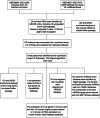
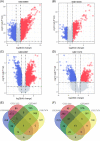
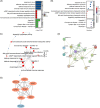

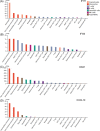
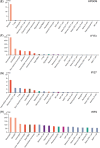


Similar articles
-
The role of differentially expressed genes and immune cell infiltration in the progression of nonalcoholic steatohepatitis (NASH) to hepatocellular carcinoma (HCC): a new exploration based on bioinformatics analysis.Nucleosides Nucleotides Nucleic Acids. 2024;43(12):1415-1430. doi: 10.1080/15257770.2024.2310044. Epub 2024 Feb 6. Nucleosides Nucleotides Nucleic Acids. 2024. PMID: 38319987
-
Exploration of the underlying comorbidity mechanism in psoriasis and periodontitis: a bioinformatics analysis.Hereditas. 2023 Feb 10;160(1):7. doi: 10.1186/s41065-023-00266-z. Hereditas. 2023. PMID: 36765431 Free PMC article.
-
Key factors and potential drug combinations of nonalcoholic steatohepatitis: Bioinformatic analysis and experimental validation-based study.Hepatobiliary Pancreat Dis Int. 2021 Oct;20(5):433-451. doi: 10.1016/j.hbpd.2021.06.001. Epub 2021 Jun 25. Hepatobiliary Pancreat Dis Int. 2021. PMID: 34233850
-
Bioinformatics analysis reveals novel core genes associated with nonalcoholic fatty liver disease and nonalcoholic steatohepatitis.Gene. 2020 Jun 5;742:144549. doi: 10.1016/j.gene.2020.144549. Epub 2020 Mar 14. Gene. 2020. PMID: 32184169
-
Elucidation of the molecular mechanism of type 2 diabetes mellitus affecting the progression of nonalcoholic steatohepatitis using bioinformatics and network pharmacology: A review.Medicine (Baltimore). 2024 Sep 13;103(37):e39731. doi: 10.1097/MD.0000000000039731. Medicine (Baltimore). 2024. PMID: 39287256 Free PMC article. Review.
Cited by
-
Key genes and immune infiltration patterns and the clinical implications in psoriasis patients.Skin Res Technol. 2024 Aug;30(8):e13889. doi: 10.1111/srt.13889. Skin Res Technol. 2024. PMID: 39120060 Free PMC article.
-
Exploring the comorbidity mechanisms between psoriasis and obesity based on bioinformatics.Skin Res Technol. 2024 Feb;30(2):e13575. doi: 10.1111/srt.13575. Skin Res Technol. 2024. PMID: 38279589 Free PMC article.
-
Determining IFI44 as a key lupus nephritis's biomarker through bioinformatics and immunohistochemistry.Ren Fail. 2025 Dec;47(1):2479575. doi: 10.1080/0886022X.2025.2479575. Epub 2025 Mar 18. Ren Fail. 2025. PMID: 40101924 Free PMC article.
-
The causal relationship between pure hypercholesterolemia and psoriasis: A bidirectional, two-sample Mendelian randomization study.Skin Res Technol. 2023 Dec;29(12):e13533. doi: 10.1111/srt.13533. Skin Res Technol. 2023. PMID: 38011000 Free PMC article.
-
Molecular Morbidity Score-Can MicroRNAs Assess the Burden of Disease?Int J Mol Sci. 2024 Jul 24;25(15):8042. doi: 10.3390/ijms25158042. Int J Mol Sci. 2024. PMID: 39125612 Free PMC article. Review.
References
MeSH terms
Substances
LinkOut - more resources
Full Text Sources
Medical
Research Materials
Miscellaneous

